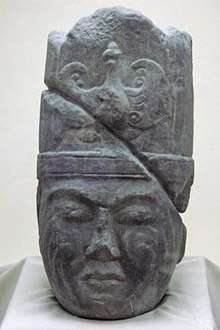Kul Tigin
Kul Tigin (Old Turkic: 𐰚𐰇𐰠𐱅𐰃𐰏𐰤, romanized: Kültegin[1] Chinese: 闕特勤[lower-alpha 1], Pinyin: Quètèqín, Wade-Giles: chüeh-t'e-ch'in, Xiao'erjing: ٿُؤ تْ ٿٍ, AD 684–731) was a general and a prince of the Second Turkic Khaganate.
Kul Tigin | |
|---|---|
 | |
| Native name | Kültegin Old Turkic: 𐰚𐰇𐰠𐱅𐰃𐰏𐰤 |
| Born | 684 |
| Died | February 27, 731 (aged 46–47) |
| Allegiance | Second Turkic Khaganate |
| Battles/wars | Battle of Bolchu Muslim conquest of Transoxiana |
| Relations | Ilterish Qaghan (father) Bilge Khagan (brother) |
Early years
He was a second son of Ilterish Qaghan, the dynasty's founder, and the younger brother of Bilge Kaghan, the fourth kaghan. He was 7 when his father died.
During the reign of Qapagan Khaghan, Kul Tigin and his older brother earned reputation for their military prowess. They defeated Yenisei Kirghiz, Turgesh, and Karluks, extending the Kaganate territory all the way to the Iron Gate (Central Asia) south of Samarkand. They also subjugated all nine of the Tokuz Oguz tribes.
In 705, Tujue forces commanded by Mojilian entered Lingwu, defeating Shazha Chongyi (沙吒忠义). Kul Tigin was commanding a unit in battle, in which he lost 3 horses.[1]
In 711, he participated in Battle of Bolchu, which was disastrous for Turgesh.[2]
In 713 he participated in subjugation of Karluk tribes with his brother and uncle.[2]
As supreme commander
Upon the death of Qapagan Khaghan, his son Inel Qaghan attempted to illegally ascend to the throne, defying the traditional Lateral succession law, but Kül Tigin refused to recognize the takeover. He raised an army, attacked, and killed Inel, Ashina Duoxifu and his trusted followers. He placed his elder brother Bilge Khagan on the throne, and took the title of Shad, an equivalent of commander-in-chief of the army for himself.
Death

He died suddenly in 27 February 731. A stele in memory of Kül Tigin, which included inscriptions in both the Turkic and Chinese, was erected at his memorial complex at the present site of Khöshöö-Tsaidam.[3] Kül-Tegin is also mentioned in the inscription erected in memory of his older brother Bilge Kagan at the neighbouring site of Khöshöö-Tsaidam-1.
His burial ceremony took place in 1 November 731. He was posthumously renamed Inanču Apa Yarğan Tarqan Old Turkic: 𐰃𐰤𐰨𐰆:𐰯𐰀:𐰖𐰺𐰍𐰣:𐱃𐰺𐰴𐰣 by Bilge Khagan.
The headdress on the glabella part of Kül Tigin sculpture in the Khöshöö-Tsaidam enclave (Orkhon, Northern Mongolia) carries a bird with wings spread like an eagle, personifying a raven.[4]
Popular culture
He was portrayed by Ham Suk Hun (함석훈) in Korean TV Series Dae Jo Yeong.
Notes
- erroneously 阙特勒 Quètèlè
References
- Kultegin’s Memorial Complex, TÜRIK BITIG
- Ahmet., Taşağil (1995–2004). Gök-Türkler. Atatürk Kültür, Dil, ve Tarih Yüksek Kurumu (Turkey). Ankara: Türk Tarih Kurumu Basımevi. ISBN 975161113X. OCLC 33892575.CS1 maint: date format (link)
- Sören Stark, Die Alttürkenzeit in Mittel- und Zentralasien (Nomaden und Sesshafte, Band 6), Reichert: Wiesbaden 2008, pp. 76–78
- Yu. Zuev, "Early Türks: Sketches of history and ideology", Almaty, Daik-Press, 2002, p. 25, ISBN 9985-4-4152-9
- Talat Tekin, A Grammar of Orkhon Turkic. Indiana University Uralic and Altaic Series, vol. 69 (Bloomington/The Hague: Mouton, 1968)
- 新疆维吾尔自治区民族事务委員会、新疆民族辞典, 乌鲁木齐:新疆人民出版社,1995 [Xinjiang Uygur Autonomous District Minority People's Committee, Encyclopedic Dictionary of the Xinjiang Minority Peoples, Ürümqi: Xinjiang People's Publishing Company, 1955]